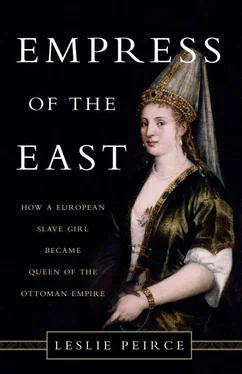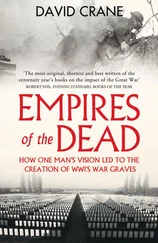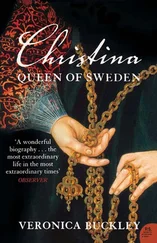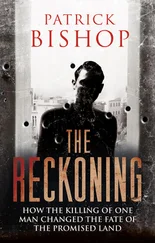In one of the earliest accounts of Mehmed II’s new palace that mention this small harem, the Genoese merchant Iacopo di Promontorio described the residents of this “second seraglio of damsels,” as he put it, as “the most splendid, well-kept, and beautiful women that could be found in the world.” [22] Campis, Records , 44.
Estimates of female numbers varied: Promontorio thought there were 150 in 1475, while Venetian envoy Alvise Sagundino reported only 10 in the late 1490s. [23] Necipoğlu, Architecture , 160.
Promontorio was probably misinformed, or else he exaggerated for effect, but numbers may have fluctuated naturally, depending on the age and sexual activity of the sultan. Sagundino was envoy to the court of Bayezid II, who was in his early fifties at the time and appears to have fathered the last of his many children in the 1470s. In any event, most of these women were staff members, not concubines.
Istanbulites were used to a constant flow of traffic between the New and Old Palaces. In addition to the sultan himself, officials, messengers, couriers, and servants went back and forth. So did princes as they got older—they lived in the Old Palace but acquired their education in part with their father’s apprentices in the New Palace. Some of those who traveled back and forth went on horseback, some by carriage, and some on foot, some singly and some with an accompanying retinue. Today it is more or less a half-hour walk from the Topkapı Palace to Istanbul University, which occupies the heart of the former Old Palace grounds. The lively if congested thoroughfare one follows has a long history. It served as the Byzantine Mese (middle way), the principal thoroughfare of Constantinople, while in Ottoman times (and still today) it was called Divan Yolu—Avenue of the Divan, the grand hall in the New Palace where the council of viziers met. This was the route Roxelana would follow on her journey to meet the sultan.
Roxelana would make her way down the Avenue of the Divan in a curtained carriage, maintaining the seclusion from the public gaze that was the duty and prerogative of women of status. According to the Frenchman Postel, a newly chosen concubine was transported to the sultan’s residence in a richly caparisoned carriage, accompanied by four or five eunuchs. [24] Postel, République , 32.
Whether or not Roxelana traveled in such splendor, she certainly went with attendants and probably a small armed guard. She would not need all her Old Palace trainers with her, for the Hall of the Maidens had its own staff adept at preparing girls for presentation to the sultan. Later, as Roxelana’s prestige grew, her trips between the two imperial residences would become more elaborate affairs.
OVER TIME ROXELANA would become a connoisseur of Istanbul’s built landscape, of both its Byzantine monuments and the Ottoman rebuilding and remodeling that had burgeoned since the conquest. She would also become a great patron of the capital, leaving her own mark on the city’s face. It is tempting, then, to imagine her initial exposure to its imperial core. What would she have seen on her first trip “in state,” peeking guardedly from the windows of her vehicle?
The small procession turned out of the Old Palace gates onto the Avenue of the Divan. Soon it would pass by the mosque of Bayezid II, Suleyman’s grandfather, an imposing structure situated on the square that in Byzantine times had been the forum of the emperor Theodosius I. The mosque anchored a whole foundation that included a madrasa (a college that taught Islamic law and other religious sciences), a primary school, a caravanserai cum hospice, a large public bath, and the tomb of its founder. [25] Kafesçioğlu, Constantinopolis , 214–216.
Bayezid’s complex was not as large as the mammoth one endowed by his father Mehmed II. Befitting the founder of Ottoman Istanbul, the Conqueror’s foundation included, in addition to the features present in his son’s, a hospital and a library. Its eight madrasas and eight preparatory madrasas would jump-start the production of a new class of Ottoman jurists, judges, teachers, and experts on matters of religion. One of the goals of these large imperial foundations, with the services they provided and employment they offered, was the stimulation of urban development. It was critical in the war-devastated city the Ottomans needed urgently to rebuild.
If Roxelana were traveling near one of the five daily prayer times, she would see people making their way toward, or leaving, the precincts of Bayezid’s mosque. The streets were probably already congested with pedestrian traffic, as the city’s grand Covered Market was located adjacent to the mosque. Perhaps the colorful wares of peddlers working outside the bazaar walls caught her eye. Bayezid may have chosen the location of his mosque with the old bazaar in mind. It served the religious needs of Muslim shop owners, employees, and shoppers, while some of the foundation’s other services were presumably open to their Jewish and Christian counterparts as well.
As the carriage moved along the Avenue of the Divan, Roxelana would encounter one of the oldest public baths in the Ottoman city. It had been donated in 1475 by Gedik Ahmed Pasha, a man of Serbian origin, one of Mehmed’s grand viziers. Top-ranking statesmen followed their monarch’s example in endowing urban amenities whose neighborhoods sometimes went on to acquire the donor’s name—to the point that one-fifth of Istanbul neighborhoods in 1990 bore the name of an Ottoman pasha. [26] Sertoğlu, Paşalar , 5.
The next monument along Roxelana’s route was the small mosque of Atik Ali Pasha, a eunuch originally from a village near Sarajevo who served as grand vizier to Bayezid II. Commissioned in 1496, the pasha’s endowment, with its college, soup kitchen, and lodge for dervishes, straddled both sides of the Avenue.
Visible ahead, dwarfing the minaret of Atik Ali’s mosque, was the ancient Column of Constantine. It was known to the Ottomans as the “hooped column” because of the iron bands that held together its six porphyry drums. The column stood in what had been the Forum of Constantine the Great, marking the foundation of Constantinople in the year 330 as the capital of the Roman empire. The splendor of the Byzantine square, with its imposing civic buildings and houses of worship, had long since vanished. But soon the elegant small mosque of another of Bayezid’s eunuch officials, the chief treasurer Firuz Agha, slipped behind the carriage as the greatest of all Byzantine monuments loomed ahead in its majestic immensity.
The Church of the Holy Wisdom—Hagia Sophia—was the work of the emperor Justinian the Great. Its doors opened to worshipers in 537. Procopius, Justinian’s contemporary and the principal historian of his long reign, wrote of it, “The church presents a most glorious spectacle, extraordinary to those who behold it and altogether incredible to those who are told of it. In height it rises to the very heavens and overtops the neighboring houses like a ship anchored among them, appearing above the city which it adorns.” [27] Sumner-Boyd and Freely, Strolling , 39.
The enormous basilica was allegedly the first destination of Mehmed II when he entered his new capital, only hours after the last emperor, Constantine XI, gave his life defending what had been for more than a millennium the capital of the now defunct Byzantine empire.
It was said that Mehmed immediately called for an imam to recite the call to prayer inside Hagia Sophia, an act that reconsecrated the church as a mosque. The victor’s sentiments were not all triumphal, however. Tursun Beg, secretary to Mehmed’s council, biographer of “the Conqueror,” and participant in the conquest, recorded the twenty-one-year-old sultan’s reaction. Observing that the outer buildings of the church had fallen into decay in the empire’s twilight years, he “thought of the impermanence and instability of this world, and of its ultimate destruction.”
Читать дальше












